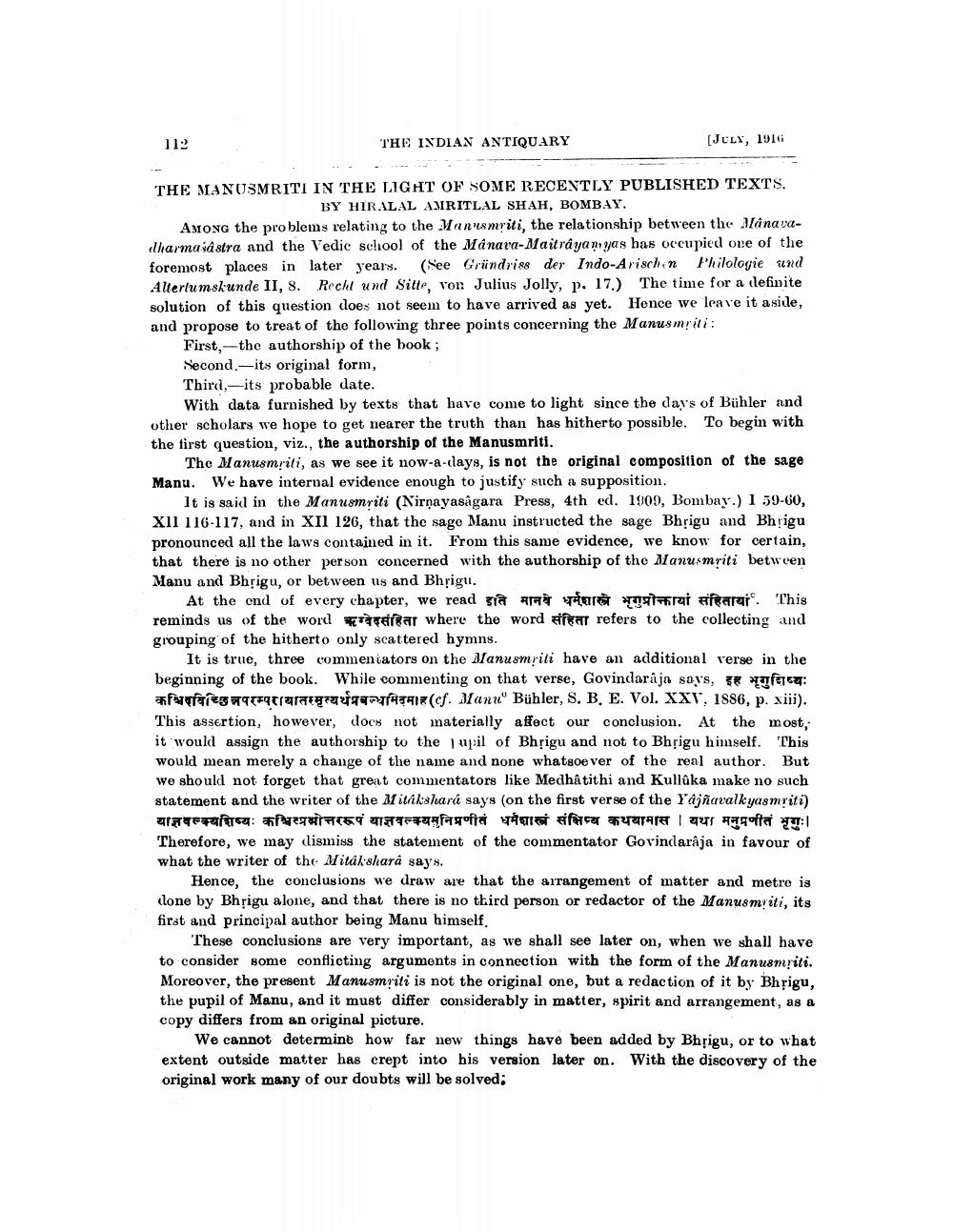________________
112
THE INDIAN ANTIQUARY
[JULY, 1916
THE MANUSMRITI IN THE LIGHT OF SOME RECENTLY PUBLISHED TEXTS.
BY HIRALAL AMRITLAL SHAH, BOMBAY. Among the problems relating to the Manusmriti, the relationship between the Nânavailharmasastra and the Vedic school of the Månava-Maitrayanyas has occupied one of the foremost places in later years. (See Gründriss der Indo-Arischen Philologie und Altertumskunde II, 8. Recht und Sitte, von Julius Jolly, p. 17.) The time for a (lefinite solution of this question does not seem to have arrived as yet. Hence we leave it a sidle, and propose to treat of the following three points concerning the Manusmriti:
First, the authorship of the book ; Second.-its original form, Third, -its probable date.
With data furnished by texts that have come to light since the days of Bühler and other scholars we hope to get nearer the truth than has hitherto possible. To begin with the first question, viz., the authorship of the Manusmriti.
The Manusmriti, as we see it now-a-days, is not the original composition of the sage Manu. We have internal evidence enough to justify such a supposition.
It is said in the Manusmriti (Nirnayasagara Press, 4th ed. 1909, Bombay.) I 59-60, XII 116-117, and in XII 126, that the sage Manu instructed the sage Bhrigu and Bhrigu pronounced all the laws contained in it. From this same evidence, we know for certain, that there is no other person concerned with the authorship of the Manusmriti between Manu and Bhrigu, or between ils and Bhrigu.
At the end of every chapter, we read इति मानवे धर्मशास्त्रे भृगुप्रोक्तायां संहितायां . This reminds us of the word rear where the word #fear refers to the collecting and grouping of the hitherto only scattered hymns.
It is true, three commentators on the Manusmriti have an additional verse in the beginning of the book. While commenting on that verse, Govindaraja says, 38 ofa: #frientatramar4 *(cf. Manu' Bühler, S. B. E. Vol. XXV, 1886, p. xiii). This assertion, however, does not materially affect our conclusion. At the most. it would assign the authorship to the wil of Bhrigu and not to Bhrigu himself. This would mean merely a change of the name and none whatsoever of the real author. But we should not forget that great commentators like Medha tithi and Kullûka make no such statement and the writer of the Mitakshará says (on the first verse of the Yajñavalkyasmriti) याज्ञवल्क्यशिष्यः कश्चित्प्रमोत्तररूपं याज्ञवल्क्यमुनिप्रणीतं धर्मशास्त्रं संक्षिप्य कथयामास | यथा मनुप्रणीतं भृगुः। Therefore, we may clismiss the statement of the commentator Govindaraja in favour of what the writer of the Miták sharâ says.
Hence, the conclusions we draw are that the arrangement of matter and metre is clone by Bhrigu alone, and that there is no third person or redactor of the Manusmriti, its first and principal author being Manu himself.
These conclusions are very important, as we shall see later on, when we shall have to consider some conflicting arguments in connection with the form of the Manusmriti. Moreover, the present Manusmriti is not the original one, but a redaction of it by Bhrigu, the pupil of Manu, and it must differ considerably in matter, spirit and arrangement, as a copy differs from an original picture.
We cannot determine how far new things have been added by Bhrigu, or to what extent outside matter has crept into his version later on. With the discovery of the original work many of our doubts will be solved:




